SIX SERIES OF TENSEGRITY
The six series which are going to be discussed are the following:
1. The Series for Preparing Intent
2. The Series for the Womb
3. The Series of the Five Concerns: The Westwood Series
4. The Separation of the Left Body and the Right Body: The Heat Series
5. The Masculinity Series
6. The Series for Devices Used in Conjunction with Specific Magical Passes
The particular magical passes of Tensegrity that comprise each of the six
conform with a criterion of maximum efficiency. In other words, each magical
pass is a precise ingredient of a formula. This is a replica of the way
in which the long series of magical passes were originally used; each series
was sufficient in itself to produce the maximum release of redeployable
energy.
In executing the magical passes, there are certain things that must be
taken into consideration in order to perform the movements with maximum
efficiency:
1. All the magical passes of the six series can be repeated as many times
as desired, unless otherwise specified. If they are first done with the
left side of the body, they must be repeated an equal number of times with
the right side. As a rule, every magical pass of the six series begins
with the left side.
2. The feet are kept separate by a distance equivalent to the shoulders'
width. This is a balanced way to distribute the weight of the body. If
the legs are spread too far apart, the balance of the body is impaired.
The same thing happens if they are too close together. The best way to
arrive at this distance is to begin from a position where the two feet
are close together (fig. 1). The tips of the feet are then pivoted on the
fixed heels and opened in a letter V shape (fig. 2). Shifting the weight
to the tips of the feet, the heels are pivoted out to the sides an equal
distance (fig. 3). The tips of the feet are brought into parallel alignment,
and the distance between the feet is roughly the width of the shoulders.
Further adjustment may be necessary here in order to reach that desired
width and to get the optimal balance of the body.
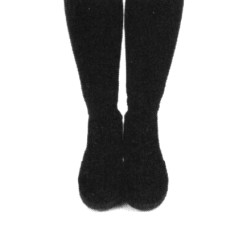 Figure 1
Figure 1
|
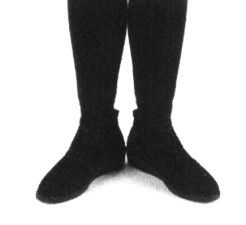 Figure 2
Figure 2
|
 Figure 3
Figure 3
|
3. During the execution of all the magical passes of Tensegrity, the knees
are kept slightly bent, so that when one is looking down, the kneecaps
block the view of the tips of the feet (figs. 4, 5), except in the case
of specific magical passes in which the knees have to be locked. Such cases
are indicated in the description of those passes. To have the knees locked
doesn't mean that the hamstrings are injuriously tense, but rather that
they are locked in a gentle way, without unnecessary force.
This position of bending the knees is a modern addition to the execution
of the magical passes, one that stems from influences of recent times.
One of the leaders of don Juan Matus's lineage was the nagual Lujan,
a sailor from China whose original name was something like Lo-Ban. He came
to Mexico around the turn of the nineteenth century, and stayed there for
the rest of his life. one of the women sorcerers in don Juan Matus's own
party went to the Orient and studied martial arts. Don Juan Matus himself
recommended that his disciples learn to move in a disciplined fashion by
taking up some form of martial arts training.
Another issue to consider in reference to the slightly bent knees is that
when the legs are moved forward in a kicking motion, the knees are never
whipped. Rather, the whole leg should be moved by the tension of the muscles
of the thighs. Moving in this fashion, the tendons of the knees are never
injured.
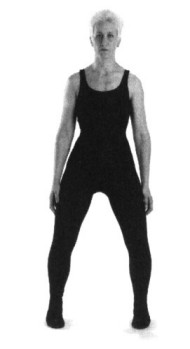 Figure 4
Figure 4
|
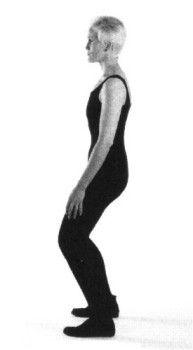 Figure 5
Figure 5
|
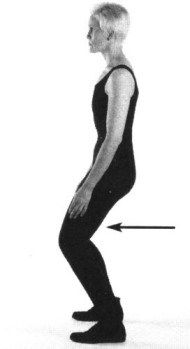 Figure 6
Figure 6
|
4. The back muscles of the legs must be tensed (fig. 6). This is a very
difficult accomplishment. Most people can learn quite easily to tense the
front muscles of the legs, but the back muscles of the legs still remain
flaccid. Don Juan said that the back muscles of the thighs are where personal
history is always stored in the body. According to him, feelings find their
home there and get stagnant. He maintained that difficulty in changing
behavior patterns could be easily attributed to the flaccidity of the back
muscles of the thighs.
5. While performing all these magical passes, the arms are always kept
slightly bent at the elbows—never fully extended—when they are moved to
strike, preventing, in this manner, the tendons of the elbows from becoming
irritated (fig. 7).
6. The thumb must always be kept in a locked position, meaning that
it is folded over the edge of the hand. It should never stick out (fig.
8). The sorcerers of don Juan's lineage considered the thumb to be a crucial
element in terms of energy and function. They believed that at the base
of the thumb exist points where energy can become stagnant, and points
that can regulate the flow of energy in the body. In order to avoid unnecessary
stress on the thumb or injury resulting from jolting the hand forcefully,
they adopted the measure of pressing the thumbs against the inside edges
of the hands.
 Figure 7
Figure 7
|
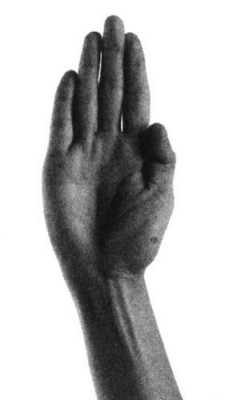 Figure 8
Figure 8
|
7. When the hand is made into a fist, the little finger is raised
to avoid an angular fist (fig. 9) in which the middle, fourth, and fifth
fingers droop. The idea is that in making a square fist (fig. 10), the
fourth and fifth fingers have to be raised, thus creating a peculiar tension
in the axilla, a tension which is most desirable for general well-being.
8. The hands, when they have to be opened, are fully extended. The tendons
of the back of the hand are at work, presenting the palm as an even, flat
surface (fig. 11). Don Juan preferred a flat palm to counteract the tendency
(established, he felt, through socialization) to present the hand as a
hollow palm (fig. 12). He said that a hollow palm was the palm of a beggar,
and that whoever practices the magical passes is a warrior, not a beggar
in the least.
 Figure 9
Figure 9
|
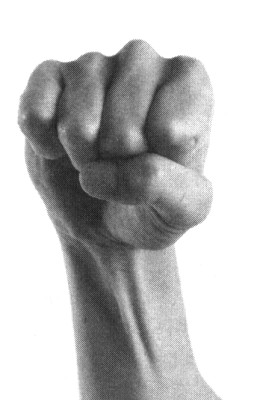 Figure 10
Figure 10
|
 Figure 11
Figure 11
|
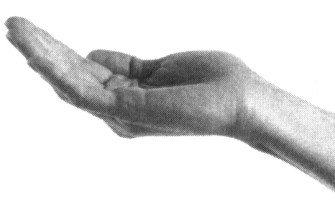 Figure 12
Figure 12
|
9. When the fingers have to be contracted at the second knuckle and bent
tightly over the palm, the tendons on the back of the hand are tensed to
the maximum, especially the tendons of the thumb (fig. 13). This tension
of the tendons creates a pressure on the wrists and forearms, areas which
sorcerers of ancient Mexico believed were key in promoting health and Wellbeing.
10. In many Tensegrity movements, the wrists have to be bent forward or
backward to an approximately ninety-degree angle by contracting the tendons
of the forearm (fig. 14). This bending must be accomplished slowly, because
most of the time the wrist is quite inflexible, and it is important that
the wrist acquire the flexibility to turn the back of the hand to make
a maximum angle with the forearm.
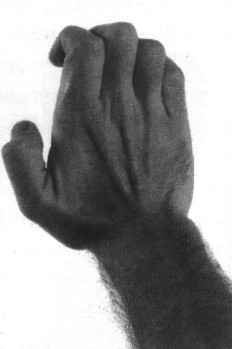 Figure 13
Figure 13
|
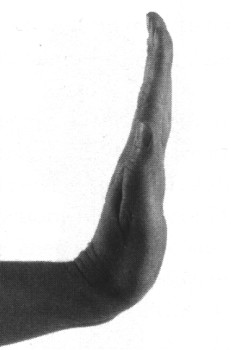 Figure 14
Figure 14
|
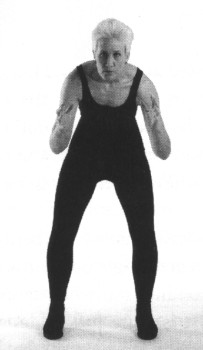 Figure 15
Figure 15
|
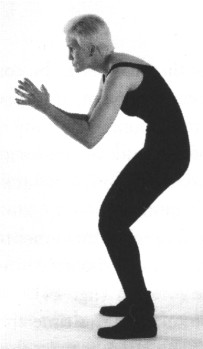 Figure 16
Figure 16
|
11. Another important issue in the practice of Tensegrity is an act
which has been termed turning the body on. This is a unique act
in which all the muscles of the body, and specifically the diaphragm, are
contracted in one instant. The muscles of the stomach and abdomen are jolted,
as are the muscles around the shoulders and shoulder blades. The arms and
legs are tensed in unison with equal force, but only for an instant (figs.
15, 16). As practitioners of Tensegrity progress in their practice, they
can learn to sustain this tension for a while longer.
Turning the body on has nothing to do with the state of perennial
bodily tension that seems to be the mark of our times. When the body is
tense with preoccupation or overwork, and the muscles of the neck are as
hard as they can be, the body is not in any way turned on. Relaxing the
muscles or arriving at a state of tranquillity is not turning the body
off, either. The idea of the sorcerers of ancient Mexico was that with
their magical passes, the body was alerted; it was made to be ready for
action. Don Juan Matus termed this condition turning the body on.
He said that when the muscular tension of turning the body on ceases,
the body is turned off naturally.
12. Breath and breathing were, according to don Juan, of supreme importance
for the sorcerers of ancient Mexico. They divided breath into breathing
with the tops of the lungs, breathing with the midsection of the lungs,
and breathing with the abdomen (figs. 17, 18, 19). Breathing by expanding
the diaphragm they called the animal breath, and they practiced
it assiduously, don Juan said, for longevity and health.
 Figure 17
Figure 17
|
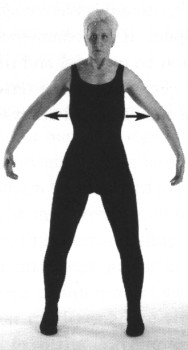 Figure 18
Figure 18
|
 Figure 19
Figure 19
|
It was don Juan Matus's belief that many of the health problems of modern
man could be easily corrected by deep breathing. He maintained that the
tendency of human beings nowadays is to take shallow breaths. One of the
aims of the sorcerers of ancient Mexico was to train their bodies, by means
of the magical passes, to inhale and exhale deeply.
It is highly recommended, therefore, in the movements of Tensegrity that
call for deep inhalations and exhalations, that these be accomplished by
slowing down the inflow or outflow of air, in order to make the inhalations
and exhalations longer and more profound.
Another important issue concerning the breathing in Tensegrity is that
breathing is normal while executing the Tensegrity movements, unless otherwise
specified in the description of any given magical pass.
13. Another consideration in performing the Tensegrity movements is the
realization that has to come to practitioners that Tensegrity is in essence
the interplay between relaxing and tensing the muscles of choice parts
of the body in order to arrive at a most coveted physical explosion, which
the sorcerers of ancient Mexico knew only as the energy of the tendons.
This is a veritable explosion of the nerves and tendons below or at the
core of the muscles.
Given that Tensegrity is the tension and relaxation of muscles, the intensity
of the muscle tension and the length of time that the muscles are kept
in that state, in any given magical pass, depends on the strength of the
participant. It is recommended that at the beginning of the practice, the
tension be minimal and the length of time as brief as possible. As the
body gets warmer, the tension should become greater and the length of time
extended, but always in a moderate fashion.
[ PREVIOUS | CONTENTS | NEXT ]




















